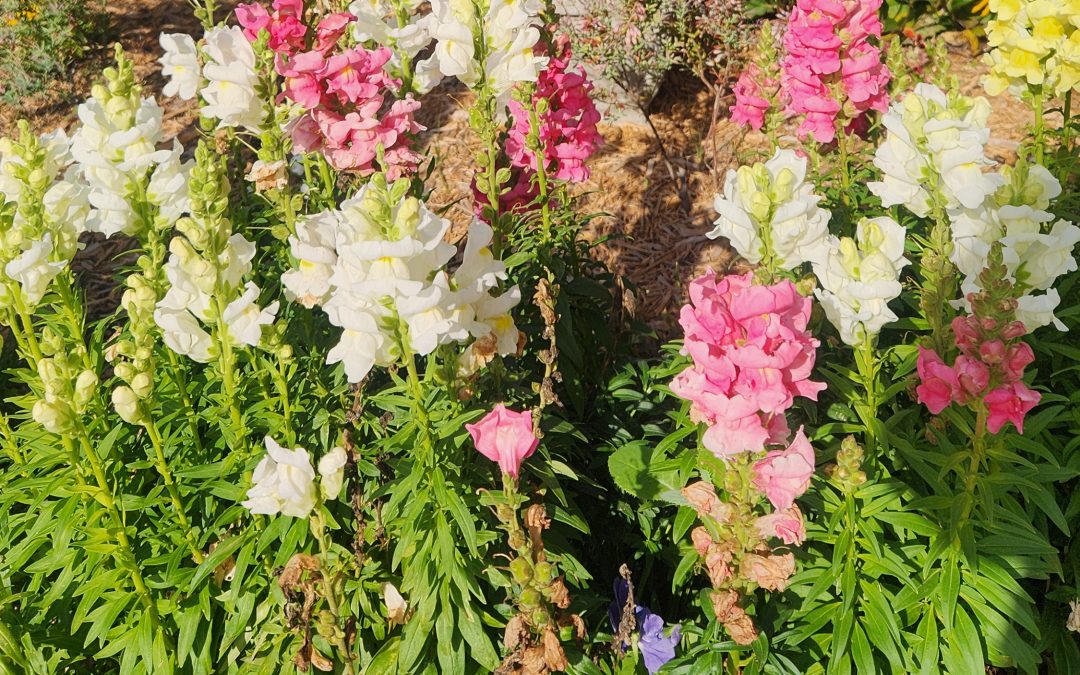
by Donna Arnold | Apr 10, 2025
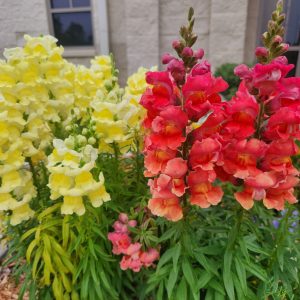
Snapdragon in bloom: Photo credit Donna Arnold FAMU Extension.
Snapdragons (Antirrhinum majus) add vibrant color to fall and winter gardens in North Florida with their wide range of hues. Colors include red, orange, yellow, and maroon. Their growth varies; tall varieties reach 2–3 feet, intermediates 1–2 feet, bedding types 6–15 inches, and rock garden hybrids about 6 inches. Dark-colored flowers often have reddish stems, while pale blooms grow on light green stems. Snapdragons’ warm-colored flowers stand out in garden beds, especially when paired with white flowers, enhancing their red, orange, and maroon tones. Their fine-textured foliage contrasts nicely with large-leaved plants and compact shrubs.
Though not native to North America, they are widely cultivated and are not considered invasive. Snapdragons are versatile and ideal for mass plantings, containers, cut flowers, and edging. They are generally available within their hardiness range, making them a popular gardener choice.
Cultivars
Dwarf: ‘Floral Carpet,’ ‘Floral Showers,’ ‘Kolibri,’ ‘Royal Carpet,’ ‘Tahiti’
Intermediate: ‘Princess,’ ‘Liberty,’ ‘Sonnet,’ ‘Pixie,’ ‘Sprite,’ ‘Cinderella’
Tall: ‘Panorama,’ ‘Burpee’s Topper,’ ‘Spring Giant,’ ‘Rocket’
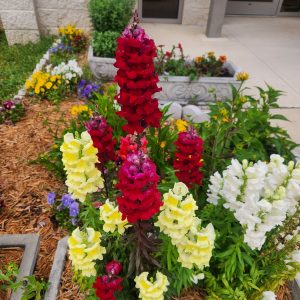
Photo credit: Donna Arnold FAMU Extension.
Care and Management
Caring for Snapdragons requires minimal work. They thrive in slightly acidic garden soil but struggle in unamended clay. Therefore, ensuring the soil remains acidic is key to their survival. They require full sun and moist soil. After the first bloom, cutting plants back to five or six nodes encourages a second flowering. Also, fertilizing at bud formation improves growth.
You can increase numbers through propagation. Propagation can be done through seeds or cuttings. Seeds germinate in 10–14 days at 70°F and should not be covered with soil. Prechilled seeds germinate best. Pinch seedlings with two to three leaf sets, except for dwarf varieties. Plant in fall for winter blooms in zones 9–11. In zone 8b and south, snapdragons may survive mild winters. Space plants 6–10 inches apart.
Pests and Diseases
Aphids: Feed on young growth, weakening plants.
Greenhouse leaf tier: Chews and webs leave; pesticides are ineffective once leaves roll.
Mites: Cause bronzed, stippled foliage, especially in hot weather.
Common Diseases
Rust: Brown pustules with yellowed leaf tissue; use proper spacing and resistant varieties.
Anthracnose: Causes sunken spots on stems and yellowing leaves; destroys infected plants.
Gray mold: Leads to wilting and stem browning; worsens in wet conditions. Remove infected stalks.
Stem rot: Cottony growth near soil line; infected plants should be removed.
Snapdragons offer rich color, versatility, and seasonal interest in gardens, making them a valuable addition for novice and experienced gardeners.
For more information contact your local extension office or click on the following links.
FPS-44/FP044: Antirrhinum majus Snapdragon
ENH1285/EP549: Planting and Propagation of Snapdragons in Florida
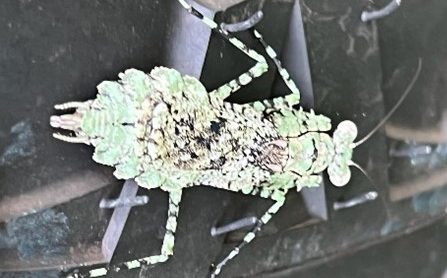
by Donna Arnold | Feb 27, 2025
Extension agents occasionally receive calls about “alien” bug sightings, sparking concern among residents. One such insect, Gonatista grisea, commonly known as the Grizzled Mantis, Florida bark Mantis or Lichen Mimic mantis, often raises alarm. But there’s no need to panic—this mantis is a fascinating and harmless part of our ecosystem.
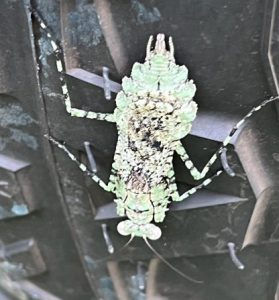
Photo Credit: Vincent Moore, Sweet Magnolia Ridge.
The Grizzled Mantis is native to the United States, ranging from southern Florida to Georgia and South Carolina, and is also found in Puerto Rico, Jamaica, and Cuba. Adults are relatively small, with males measuring 36–38 mm and females slightly larger at 37–40 mm. Their grayish-green coloration and mottled dark markings provide excellent camouflage, allowing them to blend seamlessly into their surroundings, such as lichen-covered bark. They are characterized by triangular heads and large eyes, perfect for their ambush hunting style.
Quick and agile, Grizzled Mantids scuttle rapidly away from perceived threats. They exclusively prey on arthropods, adopting a head-down ambush position while resting on tree bark. Their preferred plants include sea grape, gumbo limbo, water oak, and magnolia, though they are not limited to these species.
Interestingly, mantids are gaining popularity as low-maintenance pets. Some enthusiasts collect egg cases or purchase late-stage nymphs. However, keep in mind that newly hatched mantids require ample food or separation, as they can become cannibalistic if resources are scarce.
Whether in the wild or as pets, the Grizzled Mantis is a unique and beneficial insect, playing a role in controlling arthropod populations. So, the next time you spot one, there’s no need for fear—just appreciation for this remarkable creature!
For more information, contact your local Extension Office or click on the link Grizzled mantid – Gonatista grisea.
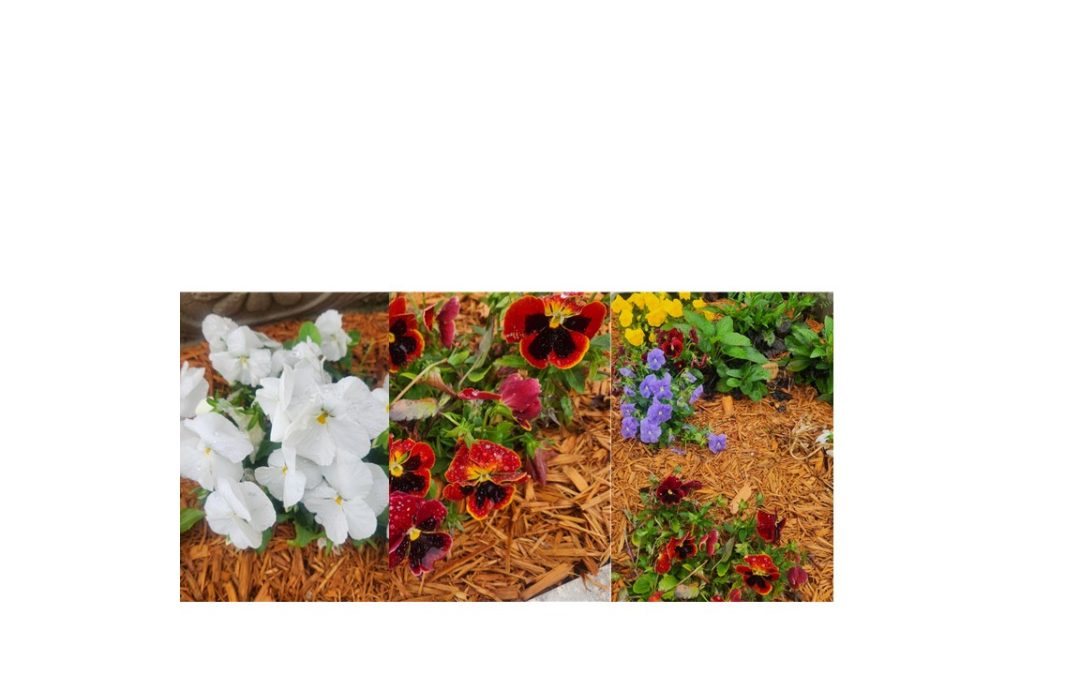
by Donna Arnold | Feb 19, 2025
 Growing pansies in North Florida is a rewarding experience, as these resilient flowers thrive in cooler temperatures. As I walked up to our front office after the ice had melted away, I was amazed to see their vibrant blooms still standing strong, displaying their cheerful faces despite the harsh conditions of the January 2025 winter storm. Their endurance is a testament to their hardiness, making them a perfect choice for winter gardens. Here’s a guide to help you successfully cultivate pansies in our region.
Growing pansies in North Florida is a rewarding experience, as these resilient flowers thrive in cooler temperatures. As I walked up to our front office after the ice had melted away, I was amazed to see their vibrant blooms still standing strong, displaying their cheerful faces despite the harsh conditions of the January 2025 winter storm. Their endurance is a testament to their hardiness, making them a perfect choice for winter gardens. Here’s a guide to help you successfully cultivate pansies in our region.
Best Planting Time
Pansies thrive in cooler weather, making fall (October–November) the ideal time to plant them. Once established, they will provide stunning blooms throughout the winter and into early spring. While they can tolerate mild frosts, Florida’s summer heat is too intense for them, so they are best treated as a seasonal flower.
Choosing the Right Variety
 Not all pansies are well-suited for Florida’s fluctuating temperatures. To ensure a successful and long-lasting display, select heat-tolerant varieties such as Majestic Giants, Matrix, or Delta Series, which are known for their resilience and vibrant blooms.
Not all pansies are well-suited for Florida’s fluctuating temperatures. To ensure a successful and long-lasting display, select heat-tolerant varieties such as Majestic Giants, Matrix, or Delta Series, which are known for their resilience and vibrant blooms.
Delta Series – A popular choice for its bold yellow, purple, and blue flowers. This variety is highly valued for its disease resistance, vigorous growth, and ability to withstand both cold and mild heat.
Majestic Giants – A classic pansy cultivar known for its large, eye-catching blooms in a variety of colors and patterns. These compact plants thrive in both container gardens and mass plantings.
Matrix Series – This variety produces dense, bushy plants with large flowers, making it an excellent choice for creating colorful, impactful displays in both garden beds and containers.
By choosing the right variety, you can ensure your pansies thrive throughout the cooler months, bringing beauty and color to your landscape.
Sun and Soil Requirements
For the healthiest plants, provide full sun to partial shade, with at least 4–6 hours of direct sunlight each day. Pansies prefer well-draining soil rich in organic matter, with a slightly acidic to neutral pH (5.5–6.5). Improve your soil’s structure by adding compost or peat moss, which enhances both drainage and nutrient content.
Watering & Care
Maintaining proper moisture levels is key to keeping pansies healthy. Water them 2–3 times a week, ensuring the soil remains moist but not soggy. A layer of mulch will help retain moisture and reduce weed growth. To encourage continuous blooms, apply a balanced, slow-release fertilizer every few weeks and remove spent flowers (deadheading) to keep plants looking fresh and vibrant.
Common Challenges & Solutions
Despite their hardiness, pansies can face a few challenges:
Heat Sensitivity: If temperatures rise unexpectedly, pansies may wilt. Providing afternoon shade can help them cope.
Pests: Keep an eye out for aphids, slugs, and caterpillars. Use insecticidal soap or remove pests by hand to prevent damage.
Fungal Diseases: Avoid overhead watering to prevent root rot and mildew. Ensuring good air circulation will also help reduce disease risks.
Spring Transition
As spring temperatures climb, pansies will naturally begin to decline. To maintain a colorful garden, consider replacing them with heat-tolerant flowers such as zinnias, marigolds, or vincas, which can handle Florida’s warm and humid conditions.
Their cheerful, expressive blooms make them a wonderful choice for adding color and charm to your landscape. Happy planting!
For more information contact your local extension office.

by Donna Arnold | Sep 30, 2024
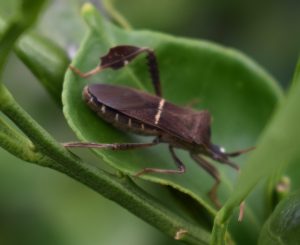
Photo Credit: Danielle S. Williams
Florida is home to at least nine species of insects from the genus Leptoglossus, some of which possess “foliaceous hind tibiae,” but only Leptoglossus phyllopus has earned the common name “leaf-footed bug.” This insect, a close relative of the stink bug, plays a fascinating yet problematic role in gardens. The nymphs are bright orange, while the adults are brown with a distinct flattened, leaf-shaped structure on their hind legs. Unfortunately, both stages of the leaf-footed bug are notorious pests, causing significant damage to buds, flowers, fruits, and seeds.
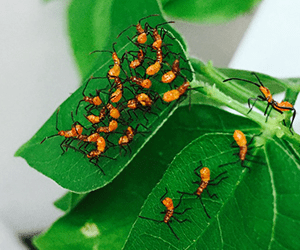
Photo Credit: Jennifer Carr
These pests feed on a wide variety of plants, including tomatoes, peaches, blueberries, beans, okra, and sunflowers. Their feeding activity can cause yellow and brown spots, misshapen fruits, and shriveled produce, depending on the severity and timing of the infestation.
In the fall, leaf-footed bugs can gather on warm windowsills or home siding. They can sometimes find openings in homes and get inside, but they don’t cause any damage indoors and don’t deposit eggs. Adult leaf-footed bugs also seek shelter in weedy areas or beneath layers of mulch and debris. They lay their eggs in neat rows on the undersides of leaves or along stems, with eggs hatching within 5 to 7 days. The nymphs then mature in approximately 25 to 30 days, leading to a rapid increase in population.
Integrated Pest Management (IPM) strategies are highly effective for controlling leaf-footed bugs. IPM involves a combination of cultural, physical/mechanical, biological, and—when necessary—chemical control methods. Following the IPM triangle approach, gardeners can start with the least harmful methods (like cultural practices) and gradually escalate to chemical controls if needed, depending on the infestation threshold. Early scouting and intervention are crucial to preventing the population from escalating throughout the growing season.
Though there are only a few organic pesticides that effectively manage leaf-footed bugs, proactive steps like hand-picking and reducing overwintering sites can help curb their numbers in the following year. For larger infestations, homeowners might consider using pyrethroids, which should be applied according to the manufacturer’s instructions. Leaf-footed bugs are also susceptible to insecticidal soaps and other pyrethroid-based products available at most garden retailers.
A word of caution: Some beneficial insects, such as assassin bugs, resemble the orange nymphs of leaf-footed bugs. Be sure to correctly identify these insects to avoid harming species that are beneficial to your garden.
For more information about leaf-footed bugs and effective control measures click on the link below or contact your local Extension office for more details.
https://edis.ifas.ufl.edu/publication/in229
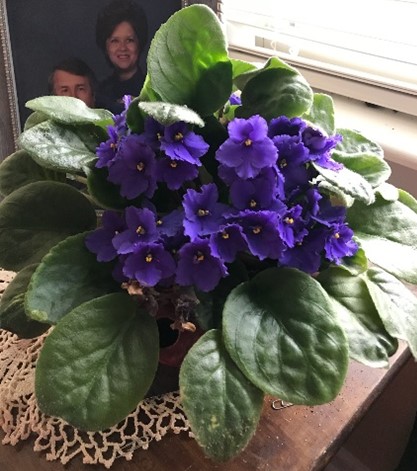
by Donna Arnold | Aug 7, 2024
Caring for African Violets: A Guide for Enthusiasts
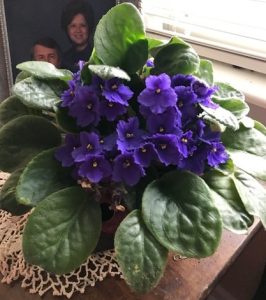
Photo Credit: Martha Mitchell.
African violets (Saintpaulia ionantha) are beloved houseplants known for their vibrant blooms and ease of growth indoors. Since their introduction to the United States, they have become favorites among plant enthusiasts for their adaptability and stunning flowers, making them staples in homes and offices. African violets thrive in bright, indirect light and moderate temperatures, and they come in various flower colors, including pink, purple, white, and combinations of these hues. Here’s how to ensure your African violets thrive with proper watering, fertilizing, and propagation.
Watering
The quality of water is crucial for African violets. Use water that is safe for drinking, making sure it is at room temperature or slightly warmer to avoid causing yellow spots on the leaves. The watering needs of African violets vary based on soil mixture, drainage, light, temperature, and humidity. For example, clay pots require more frequent watering than plastic pots due to higher evaporation rates. Water your African violets when the soil surface is dry to the touch or if wilting is noticeable.
There are two methods to water African violets: top watering and bottom watering. For top watering, apply enough water to saturate the soil and discard any excess that drains out. For bottom watering, place the pot in a container with about an inch of water. Once the soil surface becomes moist, remove the pot, let it drain, and discard any remaining water. Self-watering pots are also an option, and you can create one by making a “water wick” from a material like a braided nylon stocking. Insert the wick into one of the pot’s drainage holes and ensure it reaches the bottom of a water reservoir. Whether you water from the top or bottom, avoid letting the plant sit in water.
Fertilizing
African violets benefit from regular feeding with water-soluble fertilizers like 20-20-20 or 15-30-15. Mix the fertilizer at one-fourth the recommended rate and apply it every time you water, ensuring the soil is moist before application. If your plant shows signs of needing nutrients, such as gradual loss of leaf color, reduced growth, and fewer flowers, fertilize and observe for ten days. Be careful not to over-fertilize, as this can result in tight centers and rusty-appearing new leaves.
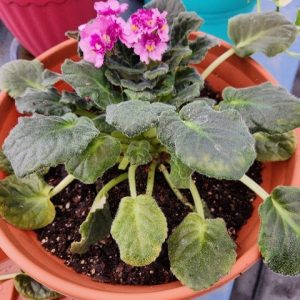
Photo credit: Donna Arnold, FAMU Extension.
Propagation
Propagating African violets is simple and can be done using leaf cuttings. Choose a healthy leaf from the middle of the plant, snap or cut it off, and trim the petiole (leaf stem) to about 1–1.5 inches. Insert the petiole into a propagation medium. Roots typically form at the petiole base within three to four weeks, new leaves appear three to four weeks and flowering occurs six to nine months later.
Additional Tips
When purchasing an African violet, it usually adapts well to its container for a while. Although these plants prefer a crowded environment, repotting them annually into lightweight potting media is advisable.
Maintaining sanitation is essential to prevent diseases. Ensure all pots, tools, and materials are clean before use. With proper care and attention, African violets can flourish, bringing beauty and joy to any indoor space. By following these guidelines on watering, fertilizing, and propagating, you can enjoy healthy and vibrant African violets in your home. for more information, contact your local Extension Office or click on the links below:
ENH17/MG028: African Violets (ufl.edu)
ENH 1096/EP360: Cultural Guidelines for Commercial Production of African Violets (Saintpaulia ionantha) (ufl.edu)














